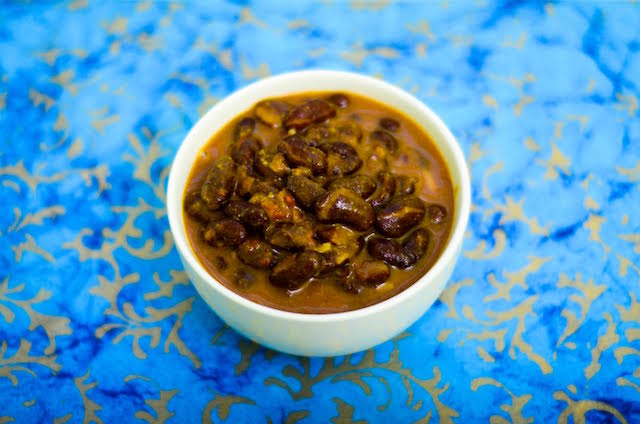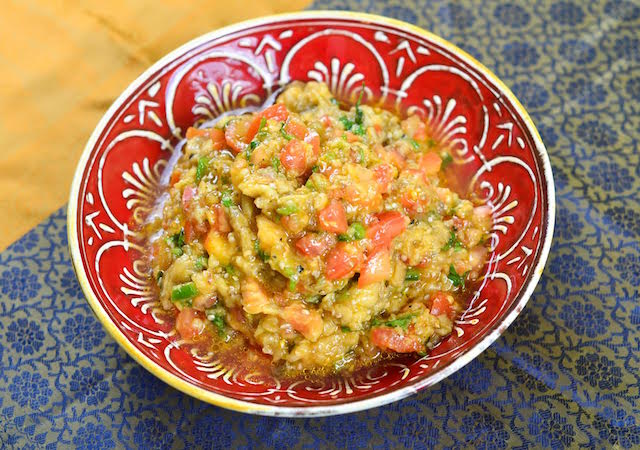
Ayurveda is a traditional Indian science of cooking.
Instead of prescribing a generic diet for the masses, Ayurveda has always focused on each and every human being.
Understanding our body type is the key to Ayurvedic cooking. Listening to our bodies, and only feeding ingredients that are best for our bodies not only makes us lead a healthy life, but also relieves our bodies from stress, weight gain and sickness.
Vata and Pitta: Red Kidney Beans

Rajma
Serves: 4
This is a very popular and easy recipe I have been sharing with many friends over the past decade. When I was a student and money was not easy to flow, I ate a lot of this curry dish. This dish is served in many north Indian temples along with plain rice. Once, my family and I decided to go to Vaishnodevi, a temple of Goddess Durga situated up in the Himalayan mountains. As we walked 12 hours up into the mountains, we were greeted by small eateries that served this dish with hot steamed rice. What a treat!
Ingredients:
2 cups canned cooked red kidney
beans, rinsed thoroughly and
drained
3 Tablespoons vegetable oil
1 Tablespoon finely chopped, peeled
fresh ginger + 1 teaspoon thinly
sliced, fresh ginger for garnish
½ cup finely chopped Roma tomato,
along with its seeds and pulp
½ teaspoon turmeric
1 Tablespoon curry powder
1 teaspoon garam masala
Salt to taste
Instructions:
In a 3-qt saucepan, heat oil over medium heat.
When the oil is hot, add ginger, tomatoes and ground spices.
Mix and cook for 5 minutes, stirring once every minute.
Add red kidney beans along with 1 cup of water.
Bring to a boil. Add salt (about 1 teaspoon or as required), stir, and mash 1/3rd of the beans to create a thick sauce.
Cook for 10 minutes. Serve.
Note:
The Red Kidney Beans are astringent in taste and heating in action. The post-digestive effect is pungent. These beans are hard, rough, and heavy in quality. These beans are good for Vata and Pitta. They will provoke or increase Kapha. So Kapha predominant people should eat them in moderation. If you are using dried beans make sure they are well soaked and well cooked. This will reduce the gas from beans and so Vata predominant people can eat without Vata disturbance. They can also add asafetida and garlic to make them more digestible. These beans have the shape of a kidney so they work as a kidney tonic. These beans are an excellent source of Vitamin B, thiamin, niacin, pyridoxine, folate, and folic acid and also great source of minerals such as magnesium and potassium. They have antioxidants. They also have Omega 3 and Omega 6 fatty acids. These beans reduce cholesterol and also stabilize blood glucose level.
Vata, Pitta and Kapha: Rice Pudding

Kheer
Serves: 4
This is the classic Indian rice pudding recipe. In winters, this is eaten warm, and in summer, it is eaten cold. I make this with cardamom as the only spice. I have seen and tried recipes that make it with nutmeg or saffron. While the basic recipe remains the same, spice will dominate the flavor of this dish.
Ingredients:
4 cups whole milk
¼ cup uncooked white basmati rice
½ teaspoon ground cardamom
¼ cup chopped unsalted cashews
¼ cup green/ golden raisins
½ cup granulated cane sugar
1 Tablespoon rose water
A pinch of salt
Instructions:
In a medium saucepan over medium heat, heat milk and rice.
Cook on low heat for 20 minutes. Stir once every 5 minutes and scrape milk scrapings (if any) from the sides of the pan and add them back into the milk.
Add cardamom, cashews, raisins, and sugar, and cook for another 5 minutes.
Finally, add a pinch of salt, and rose water while the dish is warm, stir.
Remove from heat and serve.
Note:
Rice is sweet in taste and cooling in action with a sweet post-digestive effect. It is low in fat and sodium and it is free of cholesterol. But it has tendency to retain water so Kapha predominant people should eat rice in moderation. Rice is good for all 3 doshas. The above recipe is very cooling, so it is good for Pitta dosha.
Rice is great source of carbohydrate. It has so many vitamins such as B1, B2, B3, and B5, and B6. It has minerals such as calcium, iron, magnesium, manganese, phosphorus, potassium, and zinc.
Vata and Kapha: Charred Mashed Eggplant

Baingan Chokha
Serves: 4
I was in Bihar (one of the central states of India) a few years back, and I saw eggplants being grilled on charcoal. When they were completely smoked, they were used in this recipe. That same week, I visited a friend’s aunt, and she smoked the eggplants on a gas stove to prepare this dish!
Ingredients
2 medium eggplants
3 Tablespoons mustard oil
1 cup Roma tomatoes, chopped
1 ½ inch fresh ginger, peeled and chopped
2 Tablespoons chopped cilantro
2 serrano peppers, finely chopped
Salt to taste
Instructions
On a charcoal stove or a gas stove, grill eggplants for 12 minutes. Turn them around every 3 minutes. Remove using a pair of tongs and set aside on a plate to cool for 30 minutes.
Peel and discard skin. Mash eggplant pulp.
Add the remaining ingredients and adjust salt. Serve.
Note:
Eggplant is astringent and bitter in taste and is heating in action. The post-digestive effect is pungent. It aggravates Pitta but is good for Vata and Kapha. As a member of the Nightshade family, eggplant should be in eaten in moderation by Vata predominant people. It is high in oxalic acid, so kidney and gallstone patients should not eat it. Eggplant is a good source of Manganese, Potassium, Vitamin C, Copper, Vitamin B6, Folate, Niacin, Fiber, and Phytonutrients. Eggplant kindles gastric fire and detoxifies the colon. In this recipe, mustard oil is used for preparation, so it good for Kapha predominant people.
These recipes are excerpts from the Ayurveda Cookbook, by Rupen Rau and Aparna Pattewar.
Relephant Read:
The 3-Season Diet: How & Why to Eat Ayurvedically.
Author: Rupen Rao
Editor: Emily Bartran
Photos: Pritya Books/Flickr; Author’s Own










Read 4 comments and reply